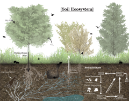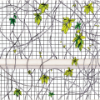New Middles

Published January 26, 2023
The Spring of 2021 fostered a foundation of support for the research and ecology of work done by Associate Professor Joyce Hwang. Hwang’s research and architecture to support middle species (mice, bats, raccoons, birds, etc.) Includes several installations across the country and in Buffalo, like the "Bat Cloud" in Buffalo’s Tifft Nature Preserve.
In the summer of 2021, Hwang was invited to participate in Exhibit Columbus’s design symposium, presentations, and exhibition, New Middles. For this opportunity, Hwang and Gregory Delaney, clinical assistant professor of architecture, worked to formulate their courses to further immerse students in faculty research through the lens of the Ecological Practices graduate studio and technical methods seminar.
Technical Methods
Through the technical methods seminar, Professor Delaney invited students to focus on researching architects who produced work in Columbus, Indiana, where the installation for New Middles was held. Students explored these sites and landscapes as methods of research, documentation and interpretation. Students were encouraged to explore ideas found in text and examples through new means of graphic representations, further developing their own graphic style. The work of the students included methods of collage and drawing to help communicate reflections on their research and studies of the precedents.
New Middles
Within the Ecological Practices studio, Hwang invited students to explore the city of Columbus, Indiana, and propose architectural interventions that reflect the design history of the area. Students examined new ways of responding to contemporary social and ecological conditions in "Middle America." Areas in this region include the culturally rural and suburban areas of the United States, typically the Lower Midwestern region consisting of Ohio, Indiana, Iowa, Missouri, Nebraska, Kansas and downstate Illinois. Students investigated ways their design proposals could impact local ecologies and the broader Mississippi Watershed, through biodiversity and new considerations of public and civic space in response to the COVID-19 pandemic.
To begin, students looked to the environment of Columbus through the lenses of surroundings and public appeal. They investigated the ways that inhabitants, human and non-human, interacted with the city. Students then explored research by analyzing the ways a specific species may use and interact with a habitat or ecosystem within Columbus. Many of these species are recognized as "Middle Species," those who play active roles in our ecosystems. However, these species remain overlooked for their work in stabilizing environments. As students learned more about these species and their behaviors, they constructed diagrams to represent the contributions and personalities of these species. Students developed individual theories based on representational maps that they created while researching Columbus and their selected middle species. The students then developed architectural interventions which enhanced the local ecologies of their areas of study. These interventions also worked to amplify the presence of the built environment in specific communities. To close the semester, students finalized their theses and worked to create compelling visual and textual narratives that support their architectural interventions and their selected middle species. Their timeline for these projects included not only interventions in Columbus, but the future of the Mississippi Watershed and "Middle America" to make an argument for the importance of design for ecological advancement and global challenges. These investigations and arguments were then to be presented within Exhibit Columbus, alongside the work of Professor Hwang.
To middle species, with love
The summer focused on the fabrication of an installation at Exhibit Columbus, an exploration of architecture, art, design, and community that activates the design legacy of Columbus, Indiana. Students, faculty and staff from multiple organizations joined Hwang in the fabrication of the installation. The collaborative process fostered valuable mentoring relationships amongst these students, faculty and staff.
Students
Bethany Greenaway, Yogesh Ravichandar, Nicole Sarmiento, Shavindya Seneviratne, Hali Sherrif, Benjamin Wemesfelder
Faculty
Joyce Hwang (Studio), Gregory Delaney (Technical Methods)
Term
Spring 2021, Summer 2021
Program
MArch






